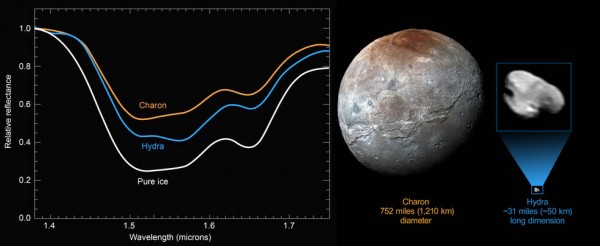By Ana Verayo, | May 09, 2016

New compositional data from NASA’s New Horizons spacecraft reveal a distinct water-ice signature on the surface of Pluto’s outermost moon, Hydra. Pluto’s largest moon Charon measures 752 miles (1,210 kilometers across), while Hydra is approximately 31 mil
After being launched in 2006, NASA's New Horizons spacecraft arrived at Pluto last July 2015 revealing a complex terrain and some unprecedented incredible features, including a mysterious lunar system.
New data from New Horizons showed that one of Pluto's moons known as Hydra, is determined to be the smallest and the farthest one from all the five moons, and more surprisingly, it is also almost covered in "pristine water ice".
Like Us on Facebook
Only little is known about Hydra, since the Pluto system is so far from our planet, at an estimated distance of 7.5 billion kilometers. Prior studies have shown that Hydra possesses a reflective surface, where these new findings now offer much crucial evidence about the mysterious, tiny moon.
This latest data that was obtained from the New Horizons spacecraft shows that there is an unmistakable water signature that is made of crystalline ice, as scientists retrieved this from infrared spectra data. With the help of the Ralph/Linear Etalon Imaging Spectral Array (LEISA) instrument, the water ice revealed an absorption of between 1.50 to 1.60 microns, and another water ice spectral feature measured at 1.65 microns. This also suggests that this water ice is similar to the material found on Pluto's major moon, Charon.
However, these latest findings show that the icy grains that were detected on the surface of Hydra contained larger particles, based on some views and observations, as opposed to those on Charon. NASA mission scientists explain that Hydra possesses deep water bands that emit a high reflectance factor which implies that there is only a little amount of contamination by darker material that accumulated over time on the surface of Charon.
Apart from this, Hydra does not also appear to be a regular shaped moon, possessing a more elongated shape, like a rough pebble. Another study also suggests that Hydra and Charon originate from the same material or cosmic object that was broken off from a violent collision millions of years ago. However, the mysterious aspect of Hydra is why does it show a different water and ice state as opposed to Charon?
According to New Horizons science team member, Simon Porter from the Southwest Research Institute in Colorado, it could be possible that micrometeorite impacts can continuously replenish the surface of Hydra by blasting off those contaminants from Charon.
To date, the New Horizons team is still collecting more data including high resolution images from the other moons as well as Pluto, to determine the origins of the presence of water ice on Hydra and Charon.
-
Use of Coronavirus Pandemic Drones Raises Privacy Concerns: Drones Spread Fear, Local Officials Say

-
Coronavirus Hampers The Delivery Of Lockheed Martin F-35 Stealth Fighters For 2020

-
Instagram Speeds Up Plans to Add Account Memorialization Feature Due to COVID-19 Deaths

-
NASA: Perseverance Plans to Bring 'Mars Rock' to Earth in 2031

-
600 Dead And 3,000 In The Hospital as Iranians Believed Drinking High-Concentrations of Alcohol Can Cure The Coronavirus

-
600 Dead And 3,000 In The Hospital as Iranians Believed Drinking High-Concentrations of Alcohol Can Cure The Coronavirus

-
COVID-19: Doctors, Nurses Use Virtual Reality to Learn New Skills in Treating Coronavirus Patients







